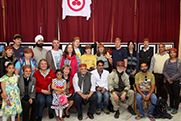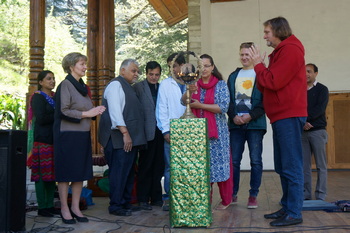|
April 15, 2018 the International Roerich Memorial Trust celebrated the 83rd anniversary of the Roerich Pact – the first international Treaty for the Protection of Artistic and Scientific Institutions and Historic Monuments initiated by the great Russian artist Nicholas Roerich who worked on its draft in early 1930s right here in the Himalayan Roerich Estate.
On this occasion, which many states and cities around the world mark as Culture Day, the IRMT organized a number of festivities. The day opened with the inauguration of the International Plein Air and Exhibition Project “Art Expedition-2018. The Himalayas” organized in cooperation with the ANO St.Petersburg Center for Humanitarian Programs represented at the event by its president Mr. Vitaly Vassilyev, and its coordinator, Mrs. Irina Dashevskaya. Under the umbrella of the project, several Russian artists have come to the IRMT to make paintings and graphics of the historic spots and structures connected with the Roerichs as well as the beautiful temples, sanctuaries and holy places of the Kullu Valley and its ancient traditions that for many years surrounded the great Russian family of artists, thinkers and scholars. The project became possible due to the active support of the VTTO Union of Artists of Russia, Embassy of the Russian Federation in the Republic of India, the representation of the Russian Government Federal Agency “Rossotrudnichestvo,” as well as the International Centre of the Roerichs (ICR), Moscow, and the Forum of Indian Photographers and Artists, Delhi. It is worthy of note that “Art Expedition-2018” holds a significant distinction of being the first ever art camp of the Russian artists on such scale hosted by the IRMT (it has united 15 professional artists).
The opening ceremony held in a traditional way started with the Sarasvati Vandana, the prayer to the Indian goddess of learning and the patroness of arts performed at the IRMT Green Theater by the students of the Helena Roerich Academy of Arts for Children managed by the IRMT. Participants of the camp and the esteemed guests of the programme lit the oil lamp and were presented with the traditional gifts – Kullu caps with local style designs.
Cordially welcoming the guests, the Indian Curator of the IRMT Mr. Ramesh Chander shared his deep appreciation of the Roerich Pact – a highly progressive document which was far beyond its time and only continues to grow in its relevance. He also mentioned that while the Pact focused on the protection of art works and monuments, it also stressed the necessity to protect the artists themselves – the very creators of cultural treasures.
Mrs. Larisa Surgina, the Russian Curator of the IRMT and the ICR employee, familiarized the guests with the meaning and the history of the Banner of Peace – the symbol of the Pact which was meant to mark the protected cultural sites. The symbol of the Banner featuring three amaranth-colour dots enclosed in a circle happens to be one of the most ancient and universal symbols of mankind and is found in the cultural and religious traditions across the world. Nicholas Roerich himself called it the sign of tri-unity and the symbol of unification.
Underscoring the continuing relevance of the Roerich Pact and the Banner of Peace Mrs. Surgina supposed that had Nicholas Roerich not been a great artist, scholar and thinker, and had his legacy been confined to the Pact alone, his name would still have been forever written in the annals of history.
Thanking the IRMT for the hearty welcome extended to the participants of the camp and for hosting the project, the President of the St.Petersburg Center for Humanitarian Programs and the organizer of the International Plein Air and Exhibition Project “Art Expedition-2018. The Himalayas” Mr. Vitaly Vassilyev expressed his confidence in the success of this undertaking and stressed that it would certainly contribute to the strengthening of the Indo-Russian cultural relations. For two weeks the visiting artists will work en plein air depicting on paper and canvas the grandeur and beauty of Naggar environs. The results of the camp are expected to be inaugurated in the Exhibition Hall of the IRMT on May 1, 2018. The exhibition will be one the key events of the programme of the Indo-Russian Culture Festival to be held in the IRMT on April 29-May 1 dedicated to the 90th anniversary of the Roerichs’ settling in the Kullu Valley. Subsequently, the exhibition will be solemnly presented to the IRMT, and on May 8 it will be displayed in the Russian Embassy in Delhi.
The programme continued with the inauguration of the exhibition of paintings by the Russian artist Natalia Zaitseva-Borisova “Holy Himalayas” in memory of the Roerichs. She exhibited some 40 works in such diverse media as oil, watercolour, tempera and gouache. Most of the paintings displayed conveyed the artist’s deeply personal and unique vision of the mighty Himalayas and the spiritual values that they have represented for millennia. Depicting a significant number of locations that inspired Nicholas and Svetoslav Roerich many decades earlier (the double-peaked Mt. Gepang, and the Kullu Valley landscapes) Mrs. Zaitseva-Borisova pays homage to the renowned Russian artists. Her watercolours masterfully capture the moods of the lofty mountain ranges in the vicinity of Naggar after snowfall and in the rainy season. Of special interest are her views of Mt. Gepang (or the “M” Mountain as the Roerichs christened it) and the series of oils depicting the ancient Buddhist monastery in Tabo, Spiti Valley, along with the age-old meditation caves overlooking it.
One more attraction of the exhibition was a tempera work showing the stone images of the local deities and heroes collected by the Roerichs and arranged under the four-trunked Himalayan pine, and the Pujari (priest) Sri Ram conducting his daily rituals in front of them. Every morning, for almost forty years now the venerable pujari has been earnestly and punctually worshipping the holy images assembled in the Roerich Estate. Already in the early 1970s he was photographed performing his duty by Mrs. Lyudmila Shaposhnikova, the writer, Roerich scholar and the future founder and director of the Non-Governmental Museum Named After Nicholas Roerich, Moscow, while visiting the Roerich Estate. Her photograph of still young Sri Ram worshipping Guga Chauhan was included in her book Along the Master’s Route.
The legendary Sri Ram was invited to the inauguration ceremony and happily had his photo taken alongside the artist.
The significant event of the celebrations was inauguration of the photographic exhibition poetically called “Frozen Moments/Anubhuti,” which displayed the works of two seasoned Indian photographers Mr. Vimal Mehta, Founder President, Forum of Indian Photographers and Artists (Delhi), and Mr. Dinesh Pagaria (Udaipur). A well-coordinated show presented both the nature and culture of India that continue to be the inexhaustible source of inspiration for anyone who comes in touch with them.
The works of Mr. Mehta opened a window into the tribal and rural life of India and successfully explored the intricate relationship between man and nature, and even man and machinery. He also presented several works celebrating the spirit of international harmony that saturates the Buddhist holy sites in India, in particular the ancient temple in Bodh Gaya and the Bodhi tree under the shade of which the Buddha is believed to have attained enlightenment two and a half millennia ago.
From his part, Mr. Pagaria who describes himself as a travel photographer shooting everything that he sees on his frequent journeys, presented a kaleidoscopic vision of India: the vivid impressions of its archaic architecture and classical dance traditions, several expressive portraits and a number of superb landscapes capturing the natural beauty of Himachal with its contrasting colours, and the naturescapes of his native state – Rajasthan – with its fleeting flocks of migratory birds and graceful flamingoes wading through the placid waters of a lake. Mr. Pagaria’s perceptive lens reminds us of the priceless moments of peace and quiet that keep occurring but often go unnoticed in our busy age.
The Roerich Pact Day became a veritable feast of Culture for the artists, Indian and Russian staff of the IRMT, its guests and visitors. It once again stressed the importance of the museum-cultural complex in the Roerich Estate as a vibrant Indo-Russian center of culture, friendship and cooperation, which was precisely the vision of its creator, Dr. Svetoslav Roerich, and the ardent wish of the entire Roerich family that did so much to bring the two great countries together.
Read also the ICR site
| 

